Project Risk Management: Benefits of Investment and Analysis Report
VerifiedAdded on 2023/01/23
|7
|1469
|71
Report
AI Summary
This report delves into the critical aspects of project risk management, emphasizing the strategic importance of investing in risk mitigation strategies. It defines risk management as the process of identifying, evaluating, and prioritizing potential threats to minimize their impact on project objectives. The report highlights the distinction between positive and negative events, classifying them as opportunities and risks, respectively. It provides a detailed discussion on project risk management, outlining its significance in project success. The report also explores the advantages of investing more in project risk management, including early risk identification, effective communication about risks, consideration of opportunities, prioritization of risks, and thorough assessment of risks. The report uses real-world examples, such as the Australian Real Estate Market and the Hudson Yards construction project, to illustrate the practical benefits of investing in project risk management. The report concludes by reiterating the importance of risk management in safeguarding project timelines, budgets, and performance.
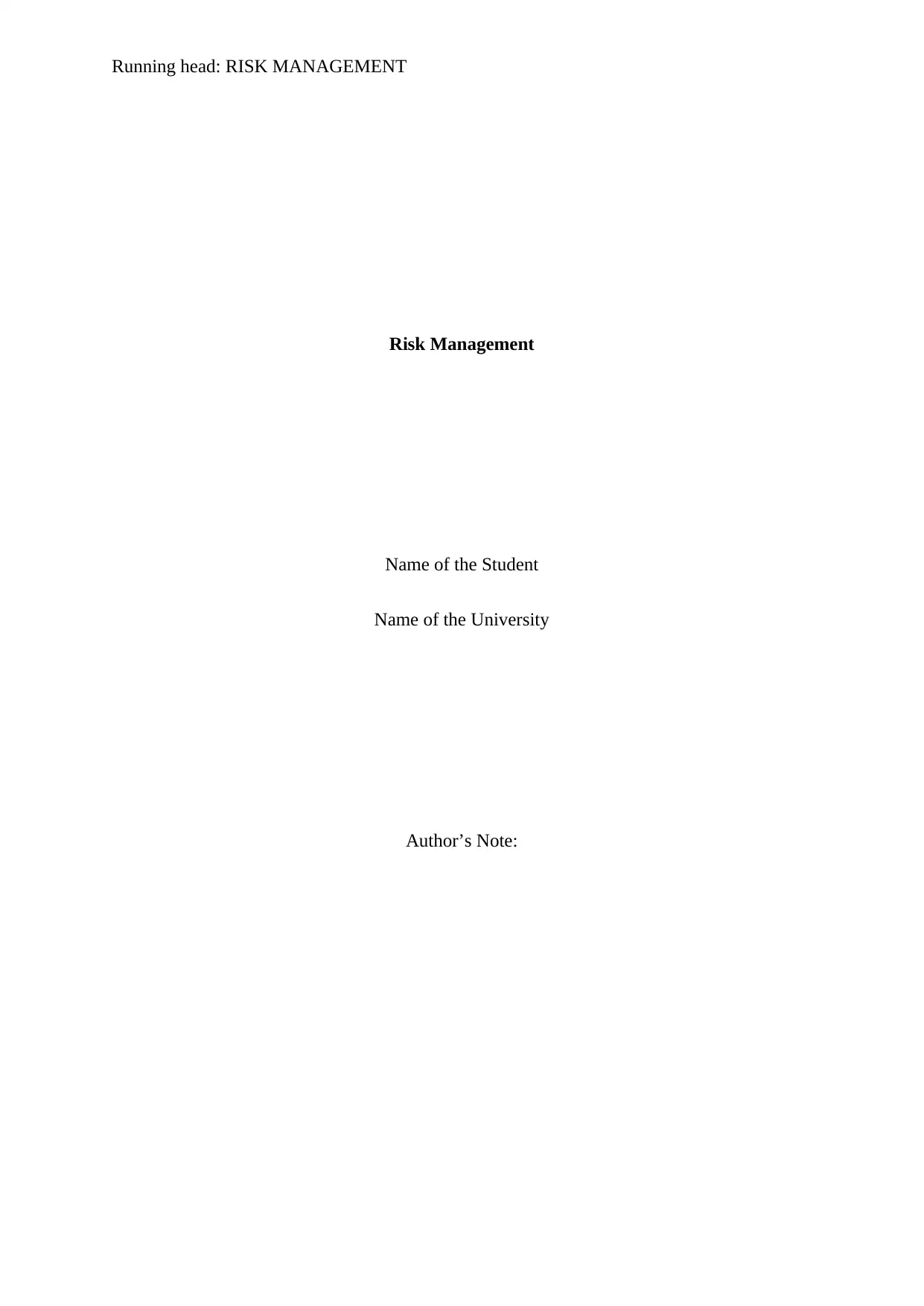
Running head: RISK MANAGEMENT
Risk Management
Name of the Student
Name of the University
Author’s Note:
Risk Management
Name of the Student
Name of the University
Author’s Note:
Paraphrase This Document
Need a fresh take? Get an instant paraphrase of this document with our AI Paraphraser
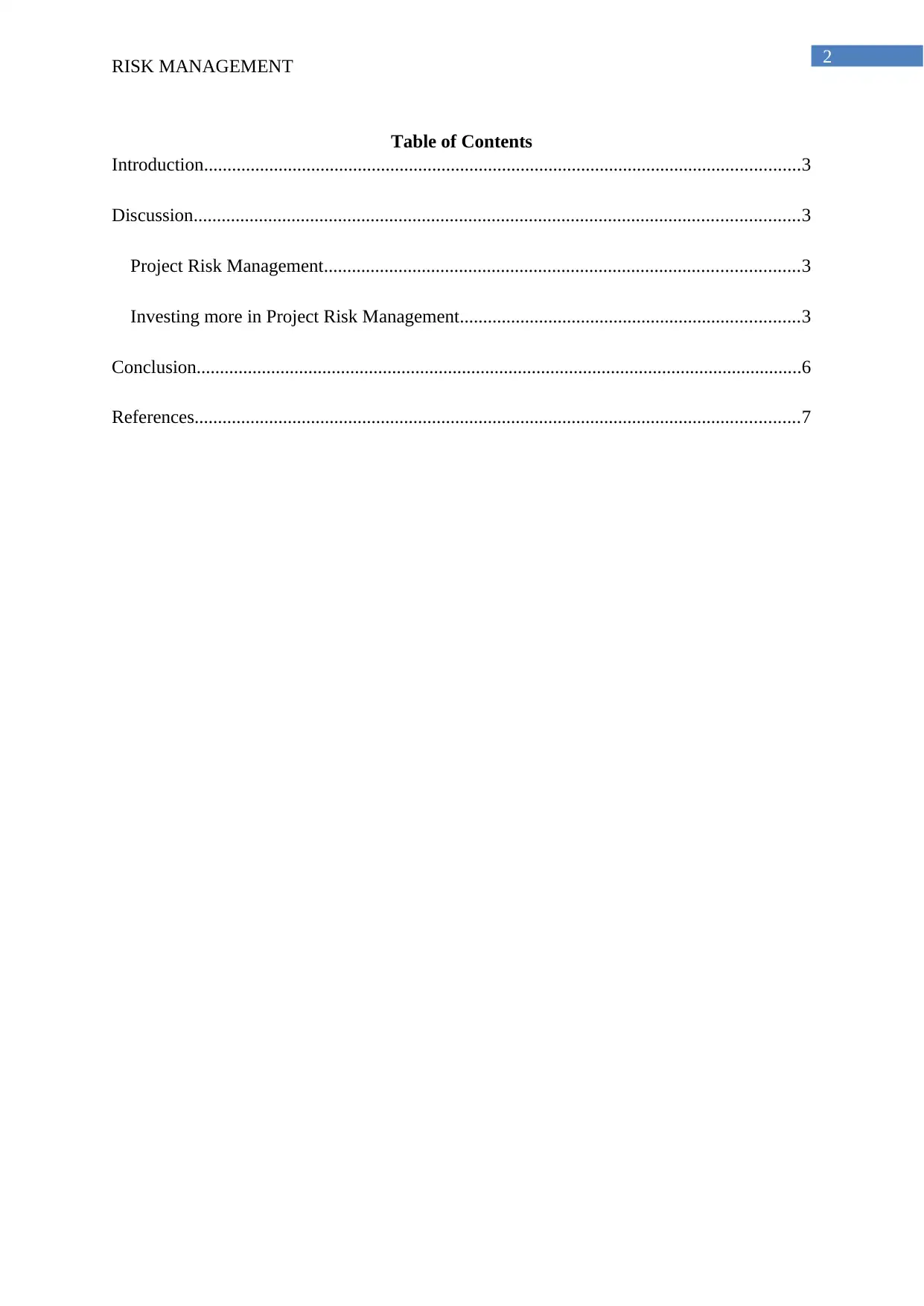
2
RISK MANAGEMENT
Table of Contents
Introduction................................................................................................................................3
Discussion..................................................................................................................................3
Project Risk Management......................................................................................................3
Investing more in Project Risk Management.........................................................................3
Conclusion..................................................................................................................................6
References..................................................................................................................................7
RISK MANAGEMENT
Table of Contents
Introduction................................................................................................................................3
Discussion..................................................................................................................................3
Project Risk Management......................................................................................................3
Investing more in Project Risk Management.........................................................................3
Conclusion..................................................................................................................................6
References..................................................................................................................................7
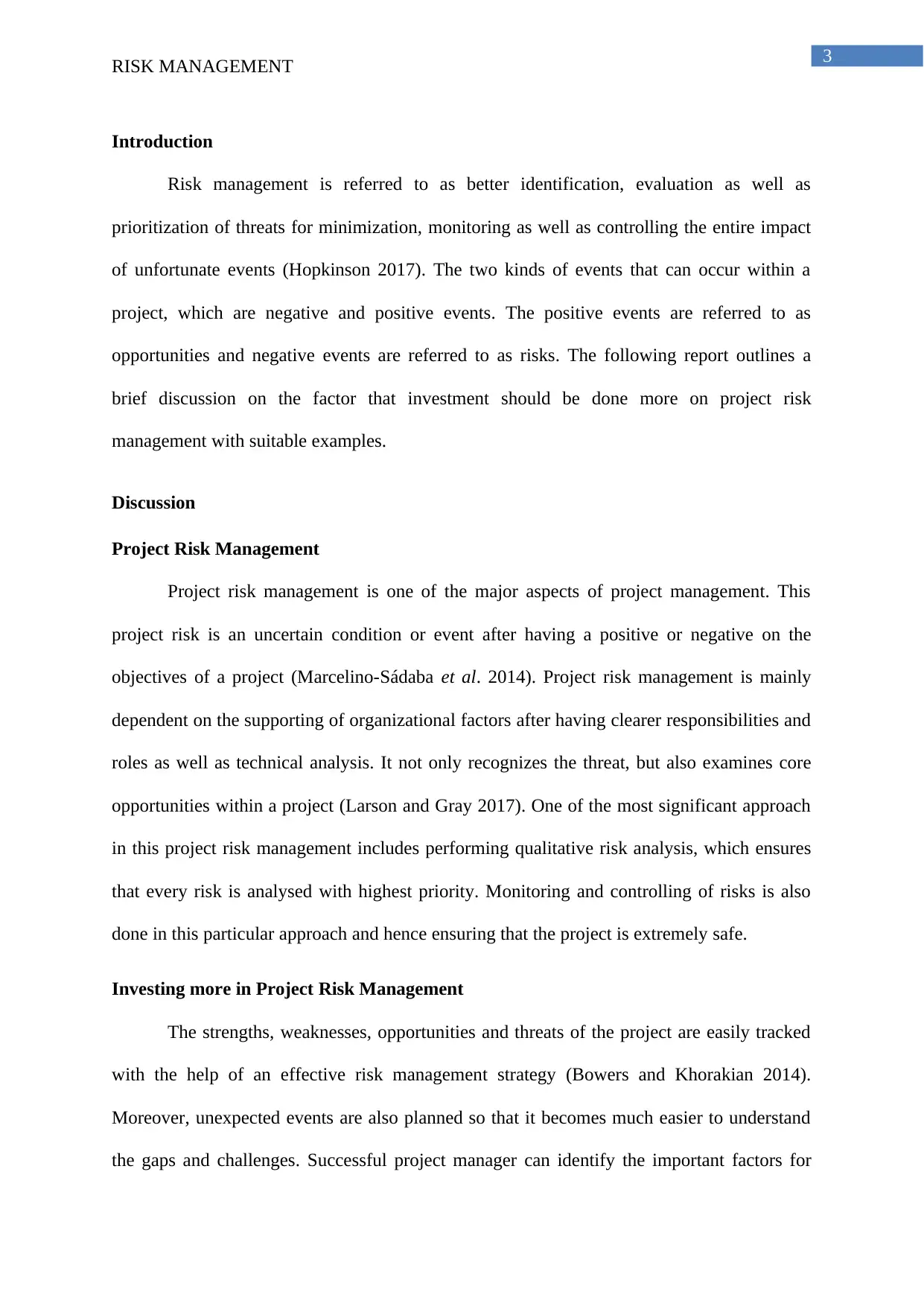
3
RISK MANAGEMENT
Introduction
Risk management is referred to as better identification, evaluation as well as
prioritization of threats for minimization, monitoring as well as controlling the entire impact
of unfortunate events (Hopkinson 2017). The two kinds of events that can occur within a
project, which are negative and positive events. The positive events are referred to as
opportunities and negative events are referred to as risks. The following report outlines a
brief discussion on the factor that investment should be done more on project risk
management with suitable examples.
Discussion
Project Risk Management
Project risk management is one of the major aspects of project management. This
project risk is an uncertain condition or event after having a positive or negative on the
objectives of a project (Marcelino-Sádaba et al. 2014). Project risk management is mainly
dependent on the supporting of organizational factors after having clearer responsibilities and
roles as well as technical analysis. It not only recognizes the threat, but also examines core
opportunities within a project (Larson and Gray 2017). One of the most significant approach
in this project risk management includes performing qualitative risk analysis, which ensures
that every risk is analysed with highest priority. Monitoring and controlling of risks is also
done in this particular approach and hence ensuring that the project is extremely safe.
Investing more in Project Risk Management
The strengths, weaknesses, opportunities and threats of the project are easily tracked
with the help of an effective risk management strategy (Bowers and Khorakian 2014).
Moreover, unexpected events are also planned so that it becomes much easier to understand
the gaps and challenges. Successful project manager can identify the important factors for
RISK MANAGEMENT
Introduction
Risk management is referred to as better identification, evaluation as well as
prioritization of threats for minimization, monitoring as well as controlling the entire impact
of unfortunate events (Hopkinson 2017). The two kinds of events that can occur within a
project, which are negative and positive events. The positive events are referred to as
opportunities and negative events are referred to as risks. The following report outlines a
brief discussion on the factor that investment should be done more on project risk
management with suitable examples.
Discussion
Project Risk Management
Project risk management is one of the major aspects of project management. This
project risk is an uncertain condition or event after having a positive or negative on the
objectives of a project (Marcelino-Sádaba et al. 2014). Project risk management is mainly
dependent on the supporting of organizational factors after having clearer responsibilities and
roles as well as technical analysis. It not only recognizes the threat, but also examines core
opportunities within a project (Larson and Gray 2017). One of the most significant approach
in this project risk management includes performing qualitative risk analysis, which ensures
that every risk is analysed with highest priority. Monitoring and controlling of risks is also
done in this particular approach and hence ensuring that the project is extremely safe.
Investing more in Project Risk Management
The strengths, weaknesses, opportunities and threats of the project are easily tracked
with the help of an effective risk management strategy (Bowers and Khorakian 2014).
Moreover, unexpected events are also planned so that it becomes much easier to understand
the gaps and challenges. Successful project manager can identify the important factors for
⊘ This is a preview!⊘
Do you want full access?
Subscribe today to unlock all pages.

Trusted by 1+ million students worldwide
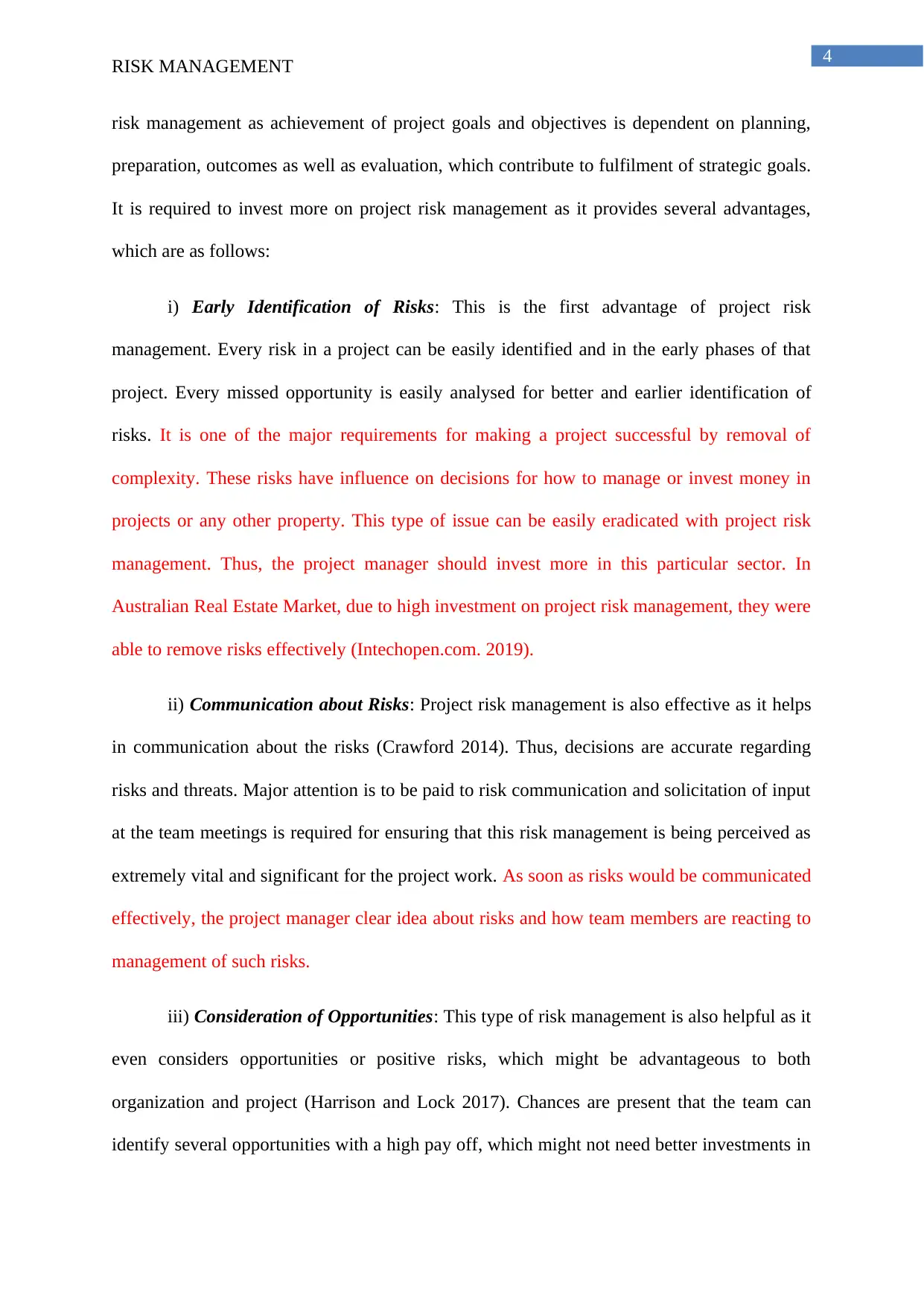
4
RISK MANAGEMENT
risk management as achievement of project goals and objectives is dependent on planning,
preparation, outcomes as well as evaluation, which contribute to fulfilment of strategic goals.
It is required to invest more on project risk management as it provides several advantages,
which are as follows:
i) Early Identification of Risks: This is the first advantage of project risk
management. Every risk in a project can be easily identified and in the early phases of that
project. Every missed opportunity is easily analysed for better and earlier identification of
risks. It is one of the major requirements for making a project successful by removal of
complexity. These risks have influence on decisions for how to manage or invest money in
projects or any other property. This type of issue can be easily eradicated with project risk
management. Thus, the project manager should invest more in this particular sector. In
Australian Real Estate Market, due to high investment on project risk management, they were
able to remove risks effectively (Intechopen.com. 2019).
ii) Communication about Risks: Project risk management is also effective as it helps
in communication about the risks (Crawford 2014). Thus, decisions are accurate regarding
risks and threats. Major attention is to be paid to risk communication and solicitation of input
at the team meetings is required for ensuring that this risk management is being perceived as
extremely vital and significant for the project work. As soon as risks would be communicated
effectively, the project manager clear idea about risks and how team members are reacting to
management of such risks.
iii) Consideration of Opportunities: This type of risk management is also helpful as it
even considers opportunities or positive risks, which might be advantageous to both
organization and project (Harrison and Lock 2017). Chances are present that the team can
identify several opportunities with a high pay off, which might not need better investments in
RISK MANAGEMENT
risk management as achievement of project goals and objectives is dependent on planning,
preparation, outcomes as well as evaluation, which contribute to fulfilment of strategic goals.
It is required to invest more on project risk management as it provides several advantages,
which are as follows:
i) Early Identification of Risks: This is the first advantage of project risk
management. Every risk in a project can be easily identified and in the early phases of that
project. Every missed opportunity is easily analysed for better and earlier identification of
risks. It is one of the major requirements for making a project successful by removal of
complexity. These risks have influence on decisions for how to manage or invest money in
projects or any other property. This type of issue can be easily eradicated with project risk
management. Thus, the project manager should invest more in this particular sector. In
Australian Real Estate Market, due to high investment on project risk management, they were
able to remove risks effectively (Intechopen.com. 2019).
ii) Communication about Risks: Project risk management is also effective as it helps
in communication about the risks (Crawford 2014). Thus, decisions are accurate regarding
risks and threats. Major attention is to be paid to risk communication and solicitation of input
at the team meetings is required for ensuring that this risk management is being perceived as
extremely vital and significant for the project work. As soon as risks would be communicated
effectively, the project manager clear idea about risks and how team members are reacting to
management of such risks.
iii) Consideration of Opportunities: This type of risk management is also helpful as it
even considers opportunities or positive risks, which might be advantageous to both
organization and project (Harrison and Lock 2017). Chances are present that the team can
identify several opportunities with a high pay off, which might not need better investments in
Paraphrase This Document
Need a fresh take? Get an instant paraphrase of this document with our AI Paraphraser
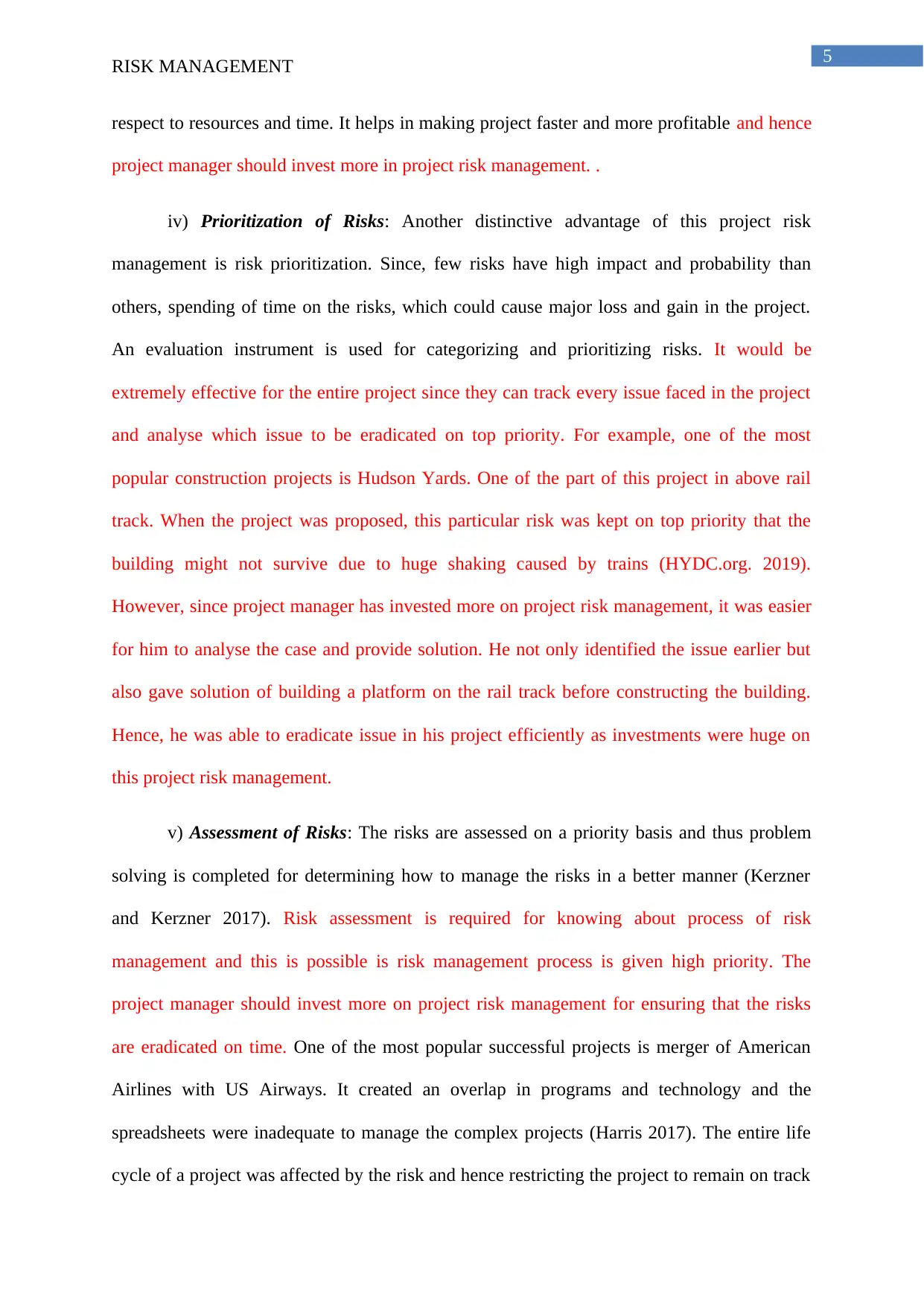
5
RISK MANAGEMENT
respect to resources and time. It helps in making project faster and more profitable and hence
project manager should invest more in project risk management. .
iv) Prioritization of Risks: Another distinctive advantage of this project risk
management is risk prioritization. Since, few risks have high impact and probability than
others, spending of time on the risks, which could cause major loss and gain in the project.
An evaluation instrument is used for categorizing and prioritizing risks. It would be
extremely effective for the entire project since they can track every issue faced in the project
and analyse which issue to be eradicated on top priority. For example, one of the most
popular construction projects is Hudson Yards. One of the part of this project in above rail
track. When the project was proposed, this particular risk was kept on top priority that the
building might not survive due to huge shaking caused by trains (HYDC.org. 2019).
However, since project manager has invested more on project risk management, it was easier
for him to analyse the case and provide solution. He not only identified the issue earlier but
also gave solution of building a platform on the rail track before constructing the building.
Hence, he was able to eradicate issue in his project efficiently as investments were huge on
this project risk management.
v) Assessment of Risks: The risks are assessed on a priority basis and thus problem
solving is completed for determining how to manage the risks in a better manner (Kerzner
and Kerzner 2017). Risk assessment is required for knowing about process of risk
management and this is possible is risk management process is given high priority. The
project manager should invest more on project risk management for ensuring that the risks
are eradicated on time. One of the most popular successful projects is merger of American
Airlines with US Airways. It created an overlap in programs and technology and the
spreadsheets were inadequate to manage the complex projects (Harris 2017). The entire life
cycle of a project was affected by the risk and hence restricting the project to remain on track
RISK MANAGEMENT
respect to resources and time. It helps in making project faster and more profitable and hence
project manager should invest more in project risk management. .
iv) Prioritization of Risks: Another distinctive advantage of this project risk
management is risk prioritization. Since, few risks have high impact and probability than
others, spending of time on the risks, which could cause major loss and gain in the project.
An evaluation instrument is used for categorizing and prioritizing risks. It would be
extremely effective for the entire project since they can track every issue faced in the project
and analyse which issue to be eradicated on top priority. For example, one of the most
popular construction projects is Hudson Yards. One of the part of this project in above rail
track. When the project was proposed, this particular risk was kept on top priority that the
building might not survive due to huge shaking caused by trains (HYDC.org. 2019).
However, since project manager has invested more on project risk management, it was easier
for him to analyse the case and provide solution. He not only identified the issue earlier but
also gave solution of building a platform on the rail track before constructing the building.
Hence, he was able to eradicate issue in his project efficiently as investments were huge on
this project risk management.
v) Assessment of Risks: The risks are assessed on a priority basis and thus problem
solving is completed for determining how to manage the risks in a better manner (Kerzner
and Kerzner 2017). Risk assessment is required for knowing about process of risk
management and this is possible is risk management process is given high priority. The
project manager should invest more on project risk management for ensuring that the risks
are eradicated on time. One of the most popular successful projects is merger of American
Airlines with US Airways. It created an overlap in programs and technology and the
spreadsheets were inadequate to manage the complex projects (Harris 2017). The entire life
cycle of a project was affected by the risk and hence restricting the project to remain on track
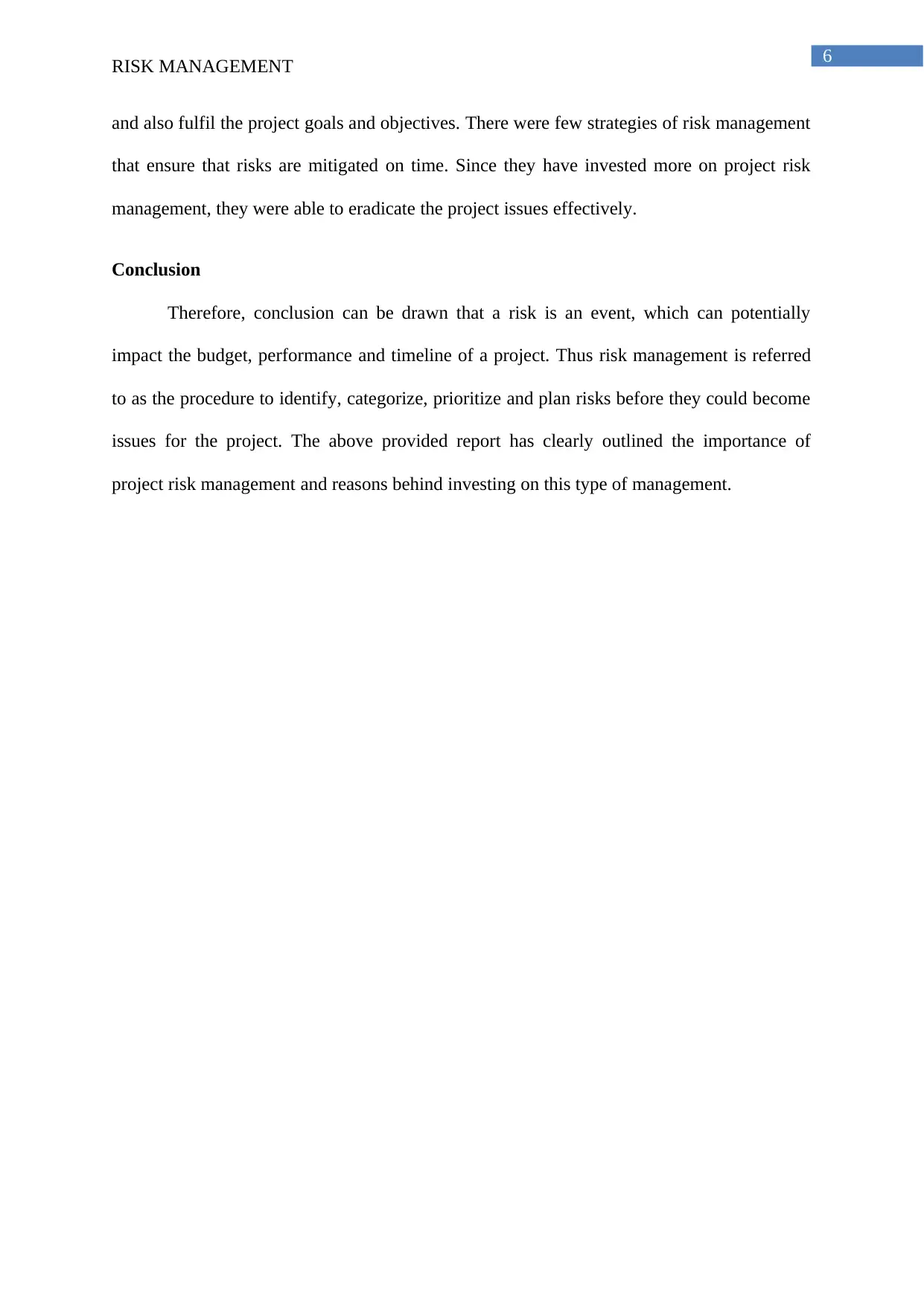
6
RISK MANAGEMENT
and also fulfil the project goals and objectives. There were few strategies of risk management
that ensure that risks are mitigated on time. Since they have invested more on project risk
management, they were able to eradicate the project issues effectively.
Conclusion
Therefore, conclusion can be drawn that a risk is an event, which can potentially
impact the budget, performance and timeline of a project. Thus risk management is referred
to as the procedure to identify, categorize, prioritize and plan risks before they could become
issues for the project. The above provided report has clearly outlined the importance of
project risk management and reasons behind investing on this type of management.
RISK MANAGEMENT
and also fulfil the project goals and objectives. There were few strategies of risk management
that ensure that risks are mitigated on time. Since they have invested more on project risk
management, they were able to eradicate the project issues effectively.
Conclusion
Therefore, conclusion can be drawn that a risk is an event, which can potentially
impact the budget, performance and timeline of a project. Thus risk management is referred
to as the procedure to identify, categorize, prioritize and plan risks before they could become
issues for the project. The above provided report has clearly outlined the importance of
project risk management and reasons behind investing on this type of management.
⊘ This is a preview!⊘
Do you want full access?
Subscribe today to unlock all pages.

Trusted by 1+ million students worldwide
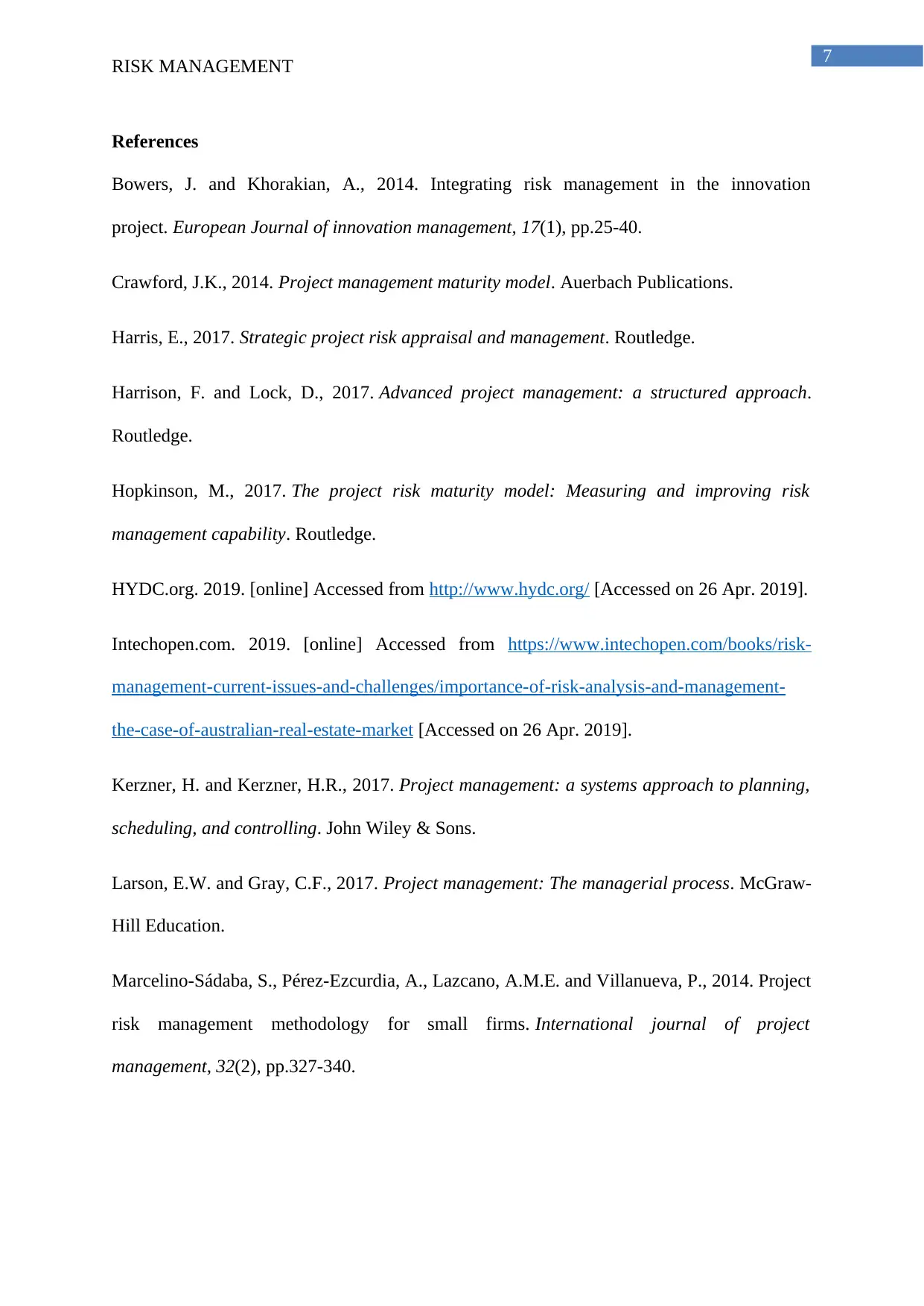
7
RISK MANAGEMENT
References
Bowers, J. and Khorakian, A., 2014. Integrating risk management in the innovation
project. European Journal of innovation management, 17(1), pp.25-40.
Crawford, J.K., 2014. Project management maturity model. Auerbach Publications.
Harris, E., 2017. Strategic project risk appraisal and management. Routledge.
Harrison, F. and Lock, D., 2017. Advanced project management: a structured approach.
Routledge.
Hopkinson, M., 2017. The project risk maturity model: Measuring and improving risk
management capability. Routledge.
HYDC.org. 2019. [online] Accessed from http://www.hydc.org/ [Accessed on 26 Apr. 2019].
Intechopen.com. 2019. [online] Accessed from https://www.intechopen.com/books/risk-
management-current-issues-and-challenges/importance-of-risk-analysis-and-management-
the-case-of-australian-real-estate-market [Accessed on 26 Apr. 2019].
Kerzner, H. and Kerzner, H.R., 2017. Project management: a systems approach to planning,
scheduling, and controlling. John Wiley & Sons.
Larson, E.W. and Gray, C.F., 2017. Project management: The managerial process. McGraw-
Hill Education.
Marcelino-Sádaba, S., Pérez-Ezcurdia, A., Lazcano, A.M.E. and Villanueva, P., 2014. Project
risk management methodology for small firms. International journal of project
management, 32(2), pp.327-340.
RISK MANAGEMENT
References
Bowers, J. and Khorakian, A., 2014. Integrating risk management in the innovation
project. European Journal of innovation management, 17(1), pp.25-40.
Crawford, J.K., 2014. Project management maturity model. Auerbach Publications.
Harris, E., 2017. Strategic project risk appraisal and management. Routledge.
Harrison, F. and Lock, D., 2017. Advanced project management: a structured approach.
Routledge.
Hopkinson, M., 2017. The project risk maturity model: Measuring and improving risk
management capability. Routledge.
HYDC.org. 2019. [online] Accessed from http://www.hydc.org/ [Accessed on 26 Apr. 2019].
Intechopen.com. 2019. [online] Accessed from https://www.intechopen.com/books/risk-
management-current-issues-and-challenges/importance-of-risk-analysis-and-management-
the-case-of-australian-real-estate-market [Accessed on 26 Apr. 2019].
Kerzner, H. and Kerzner, H.R., 2017. Project management: a systems approach to planning,
scheduling, and controlling. John Wiley & Sons.
Larson, E.W. and Gray, C.F., 2017. Project management: The managerial process. McGraw-
Hill Education.
Marcelino-Sádaba, S., Pérez-Ezcurdia, A., Lazcano, A.M.E. and Villanueva, P., 2014. Project
risk management methodology for small firms. International journal of project
management, 32(2), pp.327-340.
1 out of 7
Related Documents
Your All-in-One AI-Powered Toolkit for Academic Success.
+13062052269
info@desklib.com
Available 24*7 on WhatsApp / Email
![[object Object]](/_next/static/media/star-bottom.7253800d.svg)
Unlock your academic potential
Copyright © 2020–2025 A2Z Services. All Rights Reserved. Developed and managed by ZUCOL.





